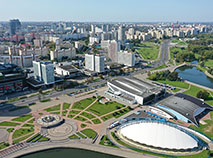Minsk city

The Svisloch River and the Trinity Suburb, Minsk
Minsk city is the capital of Belarus. It is the political, economic, scientific and cultural centre of the country and the administrative centre of the Minsk region.
Minsk is the most economically developed city in Belarus. There are 1.992,9 million inhabitants in Minsk (on 1 January 2024), and the population is constantly growing.
Transportation network in Minsk
Minsk is located on the main transportation routes connecting Western Europe and the East, regions of the Black Sea coast and the Baltic States.
Highways connect Minsk with the largest cities in Belarus: Orsha, Vitebsk, Molodechno, Brest, Slutsk, Mogilev and Gomel.
Minsk has a large railway network which connects Brest, Moscow, Vilnius and Gomel. There is a national airport in the capital.
The city has a very good public transportation system. You can easily reach any place by bus, trolleybus or tram. Minsk, like most big European cities, has a fine metro system.
Industry in Minsk
Minsk is a large industrial centre. The city produces 16% of the total volume of industrial output.
Industry within the city is diverse in nature. The main branches are:
-
food production
-
light industry
-
motor industry
-
tractor manufacturing
-
machine-tool construction
-
metal working
-
instrument making
-
radio engineering and electronic equipment manufacturing
There is a free economic zone in Minsk.
Education in Minsk
Minsk is a large educational centre within Belarus. The main educational institutions of the country, including lyceums, high schools and colleges, are concentrated in Minsk. The key institutions include:
-
Academy of Management of the President of the Republic of Belarus
-
Belarus State University
-
Belarus State Medical University
-
Belarus State Economic University
-
Belarusian National Technical University
-
Belarusian State Technological University
-
Belarusian State Academy of Arts
Culture and sport in Minsk
The capital has an extensive network of cultural establishments with 13 museums and 10 theatres, including:
-
The Belarusian State Museum of the Great Patriotic War (World War 2)
-
The National Museum of Culture and History of Belarus
-
State Musical Comedy Theatre of the Republic of Belarus
-
State Theatre of Dolls of the Republic of Belarus
Minsk has about 3,600 sports centres including stadiums and athletic fields, pools, sport centres and exercise rooms, tennis courts and a ski line.
The largest sports centres in Minsk are:
-
Dynamo Stadium
-
Sports Palace
-
Tennis Palace
-
Football Arena
-
Ice palace
Attractions in Minsk
There are numerous interesting historical places and architectural monuments, including:
-
Orthodox and Catholic Churches







 print version
print version make home page
make home page add to bookmarks
add to bookmarks













